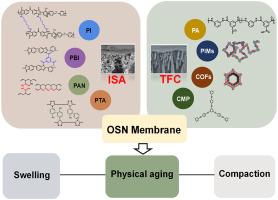The development of polymer materials and polymer membrane fabrication techniques in recent years greatly elevates the importance and feasibility of organic solvent nanofiltration (OSN) technology, while challenges from different perspectives still hinder the wider applications of polymer based OSN membranes. This article reviews the OSN membrane research specifically from the perspective of polymer membrane materials, starting by recapping the recent progress of polymer based integrally skinned asymmetric (ISA) and thin film composite (TFC) OSN membranes. Comparing to commercially available polyimide ISA membranes and polyamide TFC membranes, multiple categories of emerging polymer materials result in membranes with much improved permselectivity for highly efficient molecular separation. In view of adopting OSN membranes for engineering applications, this review also summarizes some key challenges unique to polymer membranes including material swelling, physical aging and membrane compaction, and recent efforts to overcome them. The future research direction and application prospects of polymer OSN membranes are briefly discussed in the latter part of the article, noting that improved membrane formation control and crosslinking strategies, and the development of emerging polymer membrane materials is at high necessity to break through the application constraints of OSN in terms of permselectivity and performance stability.


